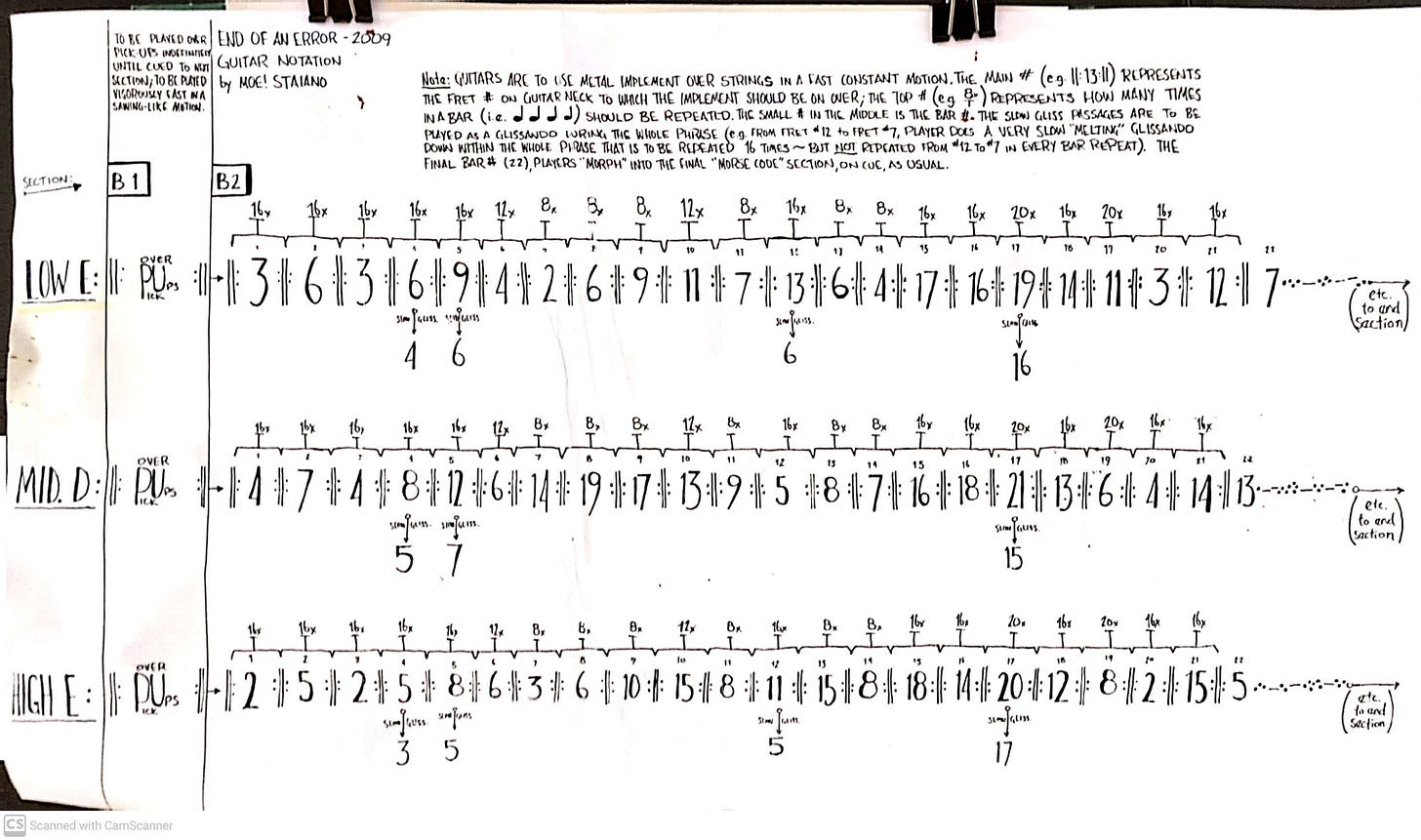Last night I fell into another YouTube rabbit hole, this time full of music with graphical notation. What made this so compelling wasn’t just having graphics replace “notes”, but the way it moved, using a pointer or cursor to help you visually follow along while the music played. You could “see” what music was coming up which heightened my anticipation as the piece unfolded. BTW, this process also works well with regular musical notation as I found out while using the MuseScore software to generate sound files from music notated in PDF’s.
Like many of you I’m familiar with graphic music scores since my early days of playing and listening to avant-garde and improvised music. Such a score often allows more freedom of expression on the part of both composer and player. And some, like me, don’t read notated music very well and find that a graphic score better displays the composer’s intent.
Below is the score I used to play one of Moe Staiano’s large ensemble pieces. While not notated, it’s not strictly graphical either. It’s kind of a hybrid with various cues to help me follow Moe’s fairly precise conducting for this piece.
My fall last night into the vagaries of YouTube’s recommendation algorithm began innocently enough when I was presented this animation from 1940. The simple thumbnail image, seen below, as opposed to the gaudy click-bait I’m often offered, was enough to peak my curiosity. This charming little piece of animation history was over way too soon, and it was the next image that I was offered that caused me to dive head first into the rabbit hole.
From the National Film Board of Canada: “An experimental film in which both sound and visuals were created entirely by Norman McLaren drawing directly upon the film with ordinary pen and ink.”
Dots by Norman McLaren 1940:
The combination of seeing the name Ligeti with that beautiful image of the score (below) was irresistible to me. As soon as you start watching you realize this is not a score meant to be played by anyone. This is a “listening score”. Ligeti wrote the piece in 1958, and in 1970 he collaborated with graphic designer Rainer Wehinger to create a “more user friendly” listening score than the one Ligeti himself had originally created. Apparently you can still buy this score as an art book if you’ve got €700.00 to spare.
Now YouTube was on a roll. After the Ligeti video, up popped one for Xenakis. Once again we’re treated to a beautiful “listening score” that adds immensely to the overall listening enjoyment, if not the understanding of this highly mathematical piece of music. Both math geniuses, Xenakis and graphic score creator Pierre Carré together make this highly complex music easy to digest. This early work by Xenakis, Pithoprakta translates to "actions through probability".
The final two offerings from YouTube last night are more recent compositions of original works using graphics to create the music. Again, the combination is mesmerizing.
In this next piece, an open source tool is used, and I’ll just let the developers describe it: “IanniX is a graphical open source sequencer, based on Iannis Xenakis works, for digital art. IanniX syncs via Open Sound Control (OSC) events and curves to your real-time environment.” Ooh Kay.
That tool is combined with a synth module that I will also let the developers describe: “The Modal CRAFTsynth is a digital monophonic synthesizer kit which can be assembled (without need to solder) in less than 10 minutes. For a small format synth kit, the Modal CRAFT features some advanced features usually only found in much higher priced synths.” Yes.
That synth module is pretty cool looking, but the resulting short piece here is even cooler:
This final piece that I watched before climbing out of the hole and into bed last night is brought to us courtesy of The Budapest Art Factory. Founded in 2006, their stated goal is to “focus on digital exhibitions … providing a platform for progressive artistic expressions often underrepresented in the local landscape, BAF attracts creative minds from diverse corners of the world.”
The mind they attracted for this piece belongs to artist Candas Sisman. His website is full of impressive looking examples of his use of digital and mechanical technologies, an area of the art world that I myself was heavily involved in in the 1980’s. Then, it was sometimes referred to as robotics. Looks like Candas has gone way beyond that.
Technology and robots aside, this piece does use some “real” instruments, featuring a cellist and trumpet player. Composed and performed during a residency in 2013, there is a nice description of it in the notes that are with this video.
So there you have it. How I spent last night following some really good recommendations from an otherwise incomprehensible YouTube algorithm. MY recommendation is to lock yourself in a darkened room and watch these things on as big a screen as possible. Enjoy.
[Thumbnail image for this story was created using openart.ai.]





...really rad recommendation...thank you...